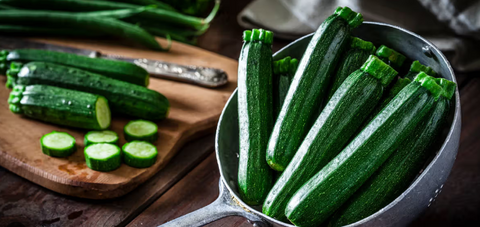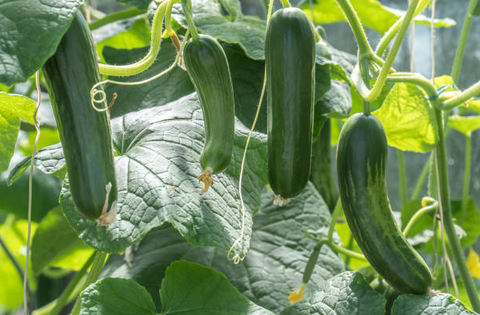When it comes to maximizing space and yield in your garden, vertical gardening techniques offer a solution that's both practical and efficient. Growing cucumbers vertically in raised beds not only saves precious ground space but also promotes better air circulation and sunlight exposure, leading to healthier plants and bountiful harvests. In this comprehensive guide, we'll delve into the intricacies of growing cucumbers upwards, from selecting the right varieties to harvesting the fruits of your labor.

Choosing the Right Cucumber Varieties
Characteristics of cucumbers suitable for vertical growing
Cucumber varieties ideal for vertical cultivation typically exhibit vigorous growth habits and produce fruits that are well-suited for climbing structures. Look for compact, vining varieties that thrive in the confined space of raised beds and have a propensity for upward growth.
Popular cucumber varieties for raised beds
Some of the top choices for vertical cucumber gardening include 'Marketmore 76', known for its disease resistance and abundant yields, and 'Sumter', prized for its crisp texture and uniform shape. Additionally, 'Lemon', with its unique round fruits, and 'Straight Eight', a classic slicing cucumber, are favored by many gardeners for their versatility and flavor.
Preparing Raised Beds
Material choices for sturdy raised beds
When choosing raised beds for vertical cucumber cultivation, opt for durable materials that provide stability and ample support for climbing structures. Wood and galvanized steel offer longevity and stability, ensuring your raised beds can withstand the weight of climbing cucumber vines and support structures.
Soil preparation and amendment for optimal growth
Before planting, enrich the soil in your raised beds with organic matter such as compost or aged manure to improve drainage and fertility. Incorporating a balanced fertilizer containing essential nutrients like nitrogen, phosphorus, and potassium will provide the necessary nourishment for healthy cucumber development.
Installing Vertical Supports
Types of supports: trellises, cages, and stakes
Vertical supports play a crucial role in guiding cucumber vines upwards and preventing sprawling growth. Trellises, consisting of sturdy frames with horizontal slats or mesh, provide ample support for climbing vines. Cages, typically constructed from wire or bamboo, offer a compact and space-saving solution for containing cucumber plants. Stakes, driven into the soil near each plant, offer vertical support for individual vines and can be paired with twine or netting for additional stability.
Proper spacing and positioning for maximum sunlight exposure
When installing vertical supports, ensure proper spacing between plants to allow for adequate airflow and sunlight penetration. Position trellises or cages on the north side of the raised bed to prevent shading and maximize exposure to sunlight throughout the day.

Planting Cucumber Seeds or Seedlings
Timing for planting cucumbers in raised beds
Cucumbers thrive in warm soil temperatures, so it's essential to wait until after the danger of frost has passed before planting. In temperate climates, sow cucumber seeds directly into the raised beds once soil temperatures reach at least 60°F (15°C). Alternatively, transplant seedlings started indoors two to three weeks before the last expected frost date for an earlier harvest.
Spacing guidelines for seedlings
When planting cucumber seedlings, space them at least 12 to 18 inches apart to allow for ample growth and airflow between plants. If using trellises or cages, position seedlings near the base of the support structure to facilitate upward growth.
Techniques for transplanting cucumber seedlings
Handle cucumber seedlings with care when transplanting them into raised beds, taking care not to disturb the delicate roots. Plant seedlings at the same depth as they were in their nursery containers and water thoroughly to promote establishment.
Training Cucumber Vines
Importance of training for vertical growth
Training cucumber vines is essential for directing their growth upwards and maximizing space utilization in raised beds. By guiding vines along vertical supports, you can prevent sprawling and ensure efficient use of available space.
Methods for guiding vines upwards
Encourage upward growth by gently securing cucumber vines to trellises or cages using soft ties or twine. As the vines grow, periodically adjust their position to prevent tangling and promote even distribution of foliage.
Pruning techniques to promote air circulation and fruit production
To maintain optimal airflow and prevent disease, regularly prune excess foliage and lateral shoots from cucumber plants. Focus on removing lower leaves and side branches that obstruct sunlight and air circulation, allowing for better penetration and reducing the risk of fungal infections.
Watering and Fertilizing Practices
Watering requirements for cucumbers in raised beds
Cucumbers have shallow roots and require consistent moisture throughout the growing season to thrive. Water raised beds deeply and evenly, ensuring that the soil remains consistently moist but not waterlogged. Mulching around plants can help retain soil moisture and suppress weed growth.
Strategies for efficient irrigation
Consider implementing drip irrigation or soaker hoses in raised beds to deliver water directly to the root zone while minimizing evaporation and runoff. Schedule watering sessions in the morning to allow foliage to dry before evening, reducing the risk of fungal diseases.
Types of fertilizers and application methods
Fertilize cucumber plants regularly with a balanced fertilizer formulated specifically for vegetables. Apply fertilizer according to package instructions, taking care not to overfeed, which can lead to excessive vegetative growth at the expense of fruit production.
Managing Pests and Diseases
Common pests affecting cucumbers in raised beds
Keep a vigilant eye out for common cucumber pests such as aphids, cucumber beetles, and spider mites, which can wreak havoc on plants if left unchecked. Monitor plants regularly and employ integrated pest management strategies to mitigate infestations.
Organic and chemical-free pest control methods
Combat pests using organic remedies such as insecticidal soap, neem oil, or diatomaceous earth, which are effective against a wide range of garden pests without harming beneficial insects. Encourage natural predators like ladybugs and lacewings to help keep pest populations in check.
Early detection and prevention of diseases
Preventative measures such as crop rotation, proper spacing, and sanitation can help minimize the risk of common cucumber diseases like powdery mildew and bacterial wilt. Remove and destroy infected plants promptly to prevent the spread of pathogens to healthy specimens.
Harvesting and Maintenance
Signs of ripe cucumbers
Harvest cucumbers when they reach their mature size and color, typically 6 to 8 inches in length for slicing varieties and smaller for pickling types. Look for firm, uniformly colored fruits with smooth skin and crisp texture, indicating peak ripeness.
Proper harvesting techniques to avoid damage
Use sharp pruning shears or a knife to cut cucumbers from the vine, taking care not to bruise or damage the delicate fruit. Harvest regularly to encourage continued production and prevent over-ripening.
Ongoing maintenance tasks for healthy cucumber plants
Maintain healthy cucumber plants by removing spent foliage, controlling weeds, and monitoring for signs of pests and diseases. Provide support for heavy fruit-laden vines to prevent damage and ensure continued upward growth.

Conclusion
In conclusion, growing cucumbers vertically in raised beds offers a space-efficient and productive gardening solution for enthusiasts of all skill levels. By selecting the right varieties, preparing sturdy raised beds, and implementing proper support structures and maintenance practices, you can enjoy a bountiful harvest of crisp, delicious cucumbers throughout the growing season. Whether you're a novice gardener or a seasoned green thumb, vertical cucumber gardening is sure to elevate your gardening experience to new heights.









